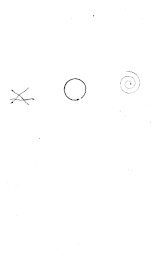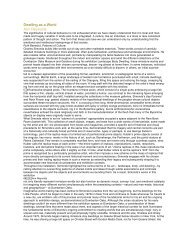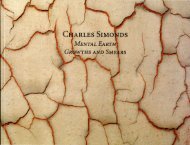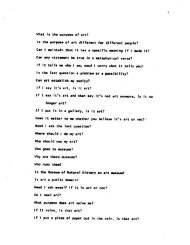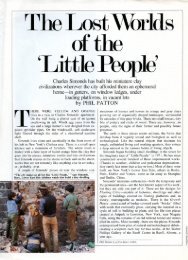Read Catalog - Charles Simonds
Read Catalog - Charles Simonds
Read Catalog - Charles Simonds
Create successful ePaper yourself
Turn your PDF publications into a flip-book with our unique Google optimized e-Paper software.
3<br />
See author's essay above, p. r s.<br />
4<br />
From conversations with the artist, 1980-8 r.<br />
5<br />
Alec Bristow, The Sex Life of Plants, New York: Holt, Rinehart<br />
and Winston, 1978, p. vii. <strong>Simonds</strong> has a copy of this book<br />
which he has annotated.<br />
6<br />
A beautifully presented discussion of the subject is The Sense<br />
of Unity: The Sufi Tradition in Persian Architecture, by Nader<br />
Ardalan and Lalch Bakhtiar, Chicago: The University of Chicago<br />
Press, 1973. <strong>Simonds</strong> has a copy, well-worn.<br />
7<br />
The most direct comparison with these dome dwellings is the<br />
type of early Pueblo dwellings from c. 300 A.D. designated as<br />
"shallow pithouses." Simple domed roofs erected over shallow<br />
depressions in the earth, pithouscs were succeeded by the circular<br />
ritual kivas, which were completely underground but retained<br />
the earlier form. See illustrations and text in Patrick<br />
Bardon and Varoujan Arzoumanian, Archi de Terre, Paris:<br />
Parentheses (editions), 1978, p. 36. This contains a discussion of<br />
the various materials according to availability and sees earth<br />
bricks (unlike tamped earth) as based on the model of stone<br />
blocks, the geometry of both allowing a regular, rectangular<br />
architecture to evolve. See also Joseph Rykwert, On Adam's<br />
House in Paradise, the Idea of the Primitive Hut in Architectuwl<br />
J-listory, New York: The Museum of Modern Art, 1972.<br />
8<br />
Probably the first extensive and systematic elaboration of colored<br />
clays as metaphors for the assimilation of various geographical<br />
regions and indigenous peoples into one culture was<br />
the installation of" D" in "Documenta 6," 1977 (pl. 21).<br />
Flatlands (yellow) connoted water and were neuteri hills (pink)<br />
were flesh and femalei and the mountains (gray) were stone and<br />
male. The shapes on top of the triangulated structures (to the<br />
left of the three sluices used to direct water to the making of the<br />
colored bricks) symbolize the three ingredients as well as their<br />
corollary in nature, man, and architecture respectively. Green,<br />
red, and gray are used in similar fashion in the two-part work<br />
"D" Early, "/'i' Later, 1977 (Walker Art Center, Minneapolis).<br />
It should be clarified that there is not a "Triangular People" to<br />
add to the Linear, Circular, and Spiral Peoples. Rather, it is a<br />
question of setting up the works in a triangular structure, looking<br />
down at the intersection of the three parts, a way of mixing<br />
the ingredients. As <strong>Simonds</strong> explained, it is "really a triangular<br />
me" (conversation with the artist, August r98r).<br />
9<br />
The Circles and Towers Growing have a general schema for<br />
installation which nevertheless is adjusted according to the<br />
proportions of the exhibition room. Separated by 7-to-8-foot<br />
intervals or more, the cycle invites free circulation among the<br />
individual works. At one point <strong>Simonds</strong> had considered showing<br />
the works abutting one another, almost as frames on a strip<br />
of film. He discarded this idea because it discouraged reading<br />
the works in reverse and imposed a closed inevitability on what<br />
he saw as a potentially unlimited number of moments possible<br />
between the r2 original works. From time to time he has also<br />
been intrigued with the idea of elaborate "Hollywood" lighting,<br />
but has thus far preferred simple angled overhead spotlights<br />
in darkened rooms.<br />
IO<br />
It should be kept in mind that Number 6 was made earlier as<br />
part of the room-scaled Picaresqne Landscape and only later incorporated<br />
into Circles and Towers Growing. In conversation<br />
<strong>Simonds</strong> has explained the disappearance of prominent details<br />
from one landscape to the next as the direct result of action by<br />
the Little People, not simple weathering.<br />
II<br />
The passage from one state to another-profane to sacredthrough<br />
images of an opening, especially openings in the roof,<br />
is discussed by Eliade, The Sacred and The Pmfane, pp. 2 5-26,<br />
and in connection with ascension myths in his Patterns in Comparative<br />
Religion, trans. Rosemary Sheed, New York: Meridian<br />
Books, pp. 99 ff.<br />
!2<br />
<strong>Simonds</strong> has made other works dealing with the theme of<br />
abandonment: Abandoned Ritual Workplace, 1975, and Abandoned<br />
Ritual Place and Abandoned Spiral of 1980. The latter<br />
two correspond approximately to the moments of decline manifest<br />
in Circles and Towers Growing, Numbers 7, 8, and r2 (pis.<br />
38, 39, and 43).<br />
13<br />
The quarry, where the earth is measured and cut into blocks to<br />
be recombined as buildings, is itself a primary metaphor for the<br />
transformation of the landscape at the hands of the Little People.<br />
The cutting away creates a repetitive geometry where none<br />
existed and on the scale of mountains. In the quarry, however,<br />
the emphasis is still more landscape than not. Nor has anything<br />
technically been builti rather the landscape is given structure<br />
as it is used up. <strong>Simonds</strong> has built several quarry works, one a<br />
simple impromptu exercise soon reworkedi the second an elaborate<br />
mountainous landscape, one side gray and terraced, the<br />
other still oozing red clay from fissures in the "rock." Exhibited<br />
as part of a larger installation at the Whitney Biennial Exhibition<br />
in 1977 and shown separately later that year at the Walker<br />
Art Center in Minneapolis, this portable Quarry was subsequently<br />
destroyed in an accident. Other quarries can be found<br />
in <strong>Simonds</strong>'s large installations, notably the Picaresque Landscape<br />
(cover ill., though not visible in this detail). <strong>Simonds</strong> also<br />
included a brick-making oven in another portable work, also<br />
now destroyed. As man-made equivalents to stone, bricks are<br />
nevertheless made of earth and therefore "softer," more organic<br />
and "human" than rock. In some of his earliest dwellings,<br />
around 1970-7!, <strong>Simonds</strong> made small rolled, rounded bricks<br />
72



